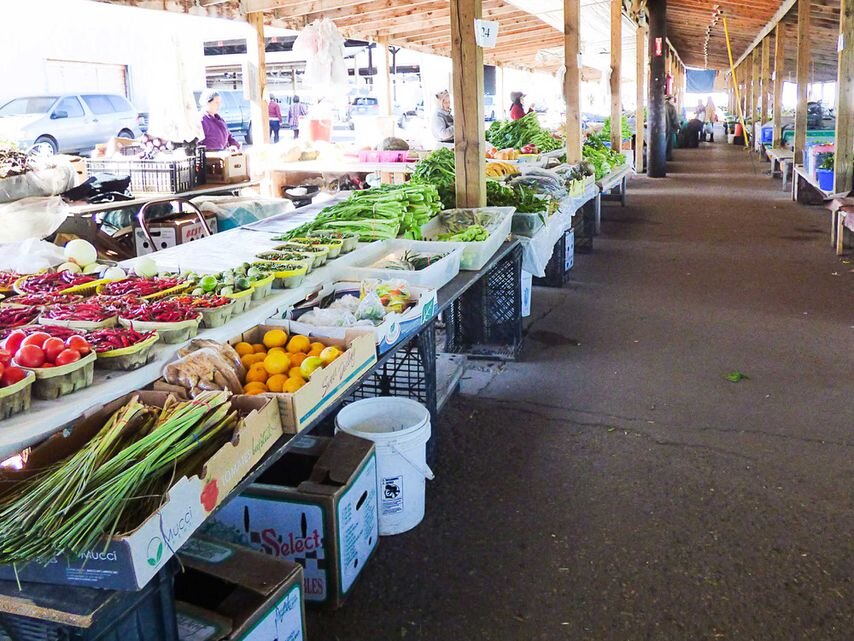Taste Stuffed Chicken Wings + Magical Herbs at St. Paul's Hmongtown Marketplace
Photo Jacqueline Raposo
The Twin Cities are home to America's largest Hmong population; here's where they shop.
for Saveur Magazine, December 11, 2015. Words a photos by Jacqueline Raposo
"I can't believe you've never brought us here before," says Gavin Kaysen to his pastry chef Diane Yang as they stroll the Hmongtown Marketplace in St. Paul, Minnesota. Kaysen, Yang, and chef de cuisine Chris Nye, the trio that heads up Spoon and Stable in neighboring Minneapolis, are marveling at lush produce they've never cooked or seen before, like piles of bulbous foreign squash and wiry stalks of winter melon. This is Kaysen's first time in the market, a sprawling 200 booths that fill three indoor and two outdoor spaces within an area that plays home to 65,000 Hmong, the largest urban concentration in the United States.
The Hmong are a rural Asian ethnic group that date back to ancient China, who then migrated into neighboring Laos, Burma, Thailand, and Vietnam during the 18th century. During the Vietnam War and the Secret War in Laos, many Hmong sided with American efforts to combat communism, and when the U.S. withdrew from Laos, a sizable group of Hmong were sent into internment camps in Thailand. The American government gave contracts to Christian groups to take in refugees in the following decades, Yang’s family among them, and the Twin Cities became a major resettlement area through Christian Charity and Lutheran Social Service programs.
The local Hmong population started to explode in the early 1980s, with Hmong opening restaurants, small service-oriented businesses, and retail shops. Hmongtown Marketplace, a pillar of the Hmong community, opened at its current site in 2004, and it's since become a destination not just for groceries and prepared food, but also medicinal herbs, textiles, and, of course, community.
The indoor spaces are wild to explore. You’ll find bright red rambutan, crisp bok choy, and small, dense bananas; an outdoor market teems with locally grown gigantic Asian yellow cucumbers, bright bitter melons, and massive stalks of lemongrass and sugar cane. Many vendors don’t speak English, but are more than happy to gesticulate, smile, and assist anyone who shows the right enthusiasm.
In a small corner of one of the buildings, a grab-bag of Southeast Asian cuisines come together for Hmong in a few stalls of freshly prepared foods: The melding of a chile pepper with bundles of herbs and softened bamboo in chicken soup; a slightly-sweet tapioca pudding in coconut milk laced with chunks of softened taro; a papaya salad made to order that’s spicy, sour, salty, and sweet, with no one flavor dominating another.
Vendors sell more than food; there’s also dried roots and herbs which have no name in English, but are “good for the stomach” or “good for your head.” Imported over-the-counter medicines sit next to large knives and scythes: “Everyone has ten of these knives in their kitchen to cut bones and such,” Yang explains. Tables are stacked two-feet high with Hmong ceremonial burial clothing: long colorful stripes running down dark, thick robes, and shoes meant to “guide feet through one of the stages of getting to the afterlife, where you walk through a patch of caterpillars.”
After picking up stalks of pea eggplant to decorate Spoon and Stable, and some natural Thai medicines, the team sat to feast on their haul from the food stalls.
Post-Quitting Thoughts - Alex Testere
“Tell the whiteys, ‘If they don’t like it, they can’t complain,” a smiling vendor joked to Yang.
They liked it all.
A Tour of Hmongtown
Thai Chiles
Hmongtown teems with these tiny spicy chiles. A common Hmong sauce, served with braised meats and greens, soups, fried chicken, or roasted offal, is a simple combination of chopped chiles and fish sauce topped with salt, occasionally cut with a little oil.
Pea Eggplant (a.k.a. "Bitter Balls")
"What are you going to do with those?" several amused Hmong women asked Kaysen as he walked through the market with two giant stalks of red and green vegetables. Very few knew how to define them, other than as a cross between melons, eggplant, and pepper they sometimes refer to as "bitter balls." They're actually a form of pea eggplant, but the bitter description is fitting, as these tiny orbs are extremely bitter when eaten raw. Their snappy skins burst into a somewhat medicinal flavor that coats the throat and doesn't ease up for a long time. The ladies suggested he stew them down with wild meat like rabbit, venison, or squirrel. Or, for the American palate: "put in a pot with chicken and beef and boil it."
Purple Lemongrass
Smell this locally-grown purple lemongrass and you’ll understand why it’s more expensive than its commercial yellow counterpart: The bulbs are smaller, the flavor is far more sharp and potent, and the fragrance is pungent and intoxicating. Lemongrass is essential in Hmong cooking; it's most simply cooked into broth by simmering the trimmed stalks that forms the base of braised green dishes and various soups.
Dried Bamboo
This bamboo is dehydrated for export, and rehydrating it takes some time; the stalks must be continually soaked in boiling water, drained, and soaked again for several days before they’re ready for cooking. But they add a wonderful fragrance and resilient texture to soups, stews, and braises. At the market, you can fittingly buy dried bamboo at the Bamboo No. 5 food stall, where it’s cooked with ground chicken and broth. While the bamboo itself is a little bitter, Yang notes it’s because the soup is often served to the elderly or sick, who prefer it that way.
Roots + Herbs for Tea
Hmong use all kinds of herbs as medicine, and you'll find an abundance of medicinal herbs at various stalls. Most only loosely translate from Hmong into English, and some aren't even referenced individually: ko taw qos liab (duck foot), tshuaj rog (fat medicine), and ntiv (sweet fern) have their own translatable names, but other than the Hmong who grow them, most don't even know what they are. Instead, they're referred to together as "cook with chicken herbs." Bags of the fresh herbs, containing whatever is growing according to the current season, are so ubiquitous with chicken soup that many Hmong buy the bags when fresh and immediately freeze them, so they have them on hand to make chicken soup when people are sick or a woman has just given birth.
Other roots and herbs are dried and used directly as medicine. Some, like burdock and ginseng, are somewhat easy to identify and describe to American buyers. Others, like the delicate leaves of the “twisted leaf” herb, are defined first as “good for stomach”: Two or three leaves steeped in hot water relieve upset stomachs and cramping. Combinations of the above are sometimes dehydrated, ground, and compressed with honey, which can then be shaved onto dishes or melted into medicinal teas.
Winter Melon
Hmong love winter melons’ thick, waxy skins so much that they carve dragons and other symbols into the surfaces. Or the melons, sometimes dubbed “Hmong pumpkin,” get hollowed out to use as soup terrines. “It’s really porous,” Yang says, “so when you cook it, it gets really spongy and doesn’t have much flavor.” Because of the high water content, winter melons are often juiced or candied for celebrations, and the skins get dehydrated and crystallized.
Radish Tops
Hmong eat lots of boiled and sautéed greens, so they let their radish greens grow thick and wild as a bonus vegetable. The green pods that emerge with the leaves are a little tough and chewy, “but Hmong people love chewy things,” Yang says. “They’re like radishes, but without the pepperiness and not as hot.”
Stuffed Chicken Wings
Food vendors at the market pay a flat $17,000 plus yearly fees to own their stalls, but high foot traffic means good food is well rewarded. And there’s plenty of good food. Cooks make papaya salad is made to order, balancing spicy, sweet, acidic, and salty flavors.Herbs are braised with pork, bamboo is tossed in chicken soup, and a local purveyor provides the stalls with a slightly spicy sausage. But one of the best dishes at the market is an order of stuffed chicken wings. The wings are skillfully deboned, then the skins stretched to the border of tearing. They’re filled with sautéed ground pork, vermicelli noodles, and herbs, and baked until the skin is crispy. It bites with a rich snap, yielding to the salty and bright filling.
Hmongtown Marketplace
217 Como Avenue, St Paul, MN 55103
(651) 487-3700
Jacqueline Raposo writes about chefs, food culture and chronic illness for outlets including Serious Eats, Tasting Table, Plate Magazine, The Village Voice, Cosmopolitan, and Elle. She's the host of Love Bites Radio on Heritage Radio Network and is the gluten-free baker behind The Dusty Baker. Find her work at Words Food Art and gab away with her on Twitter and Instagram.













